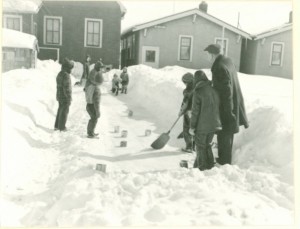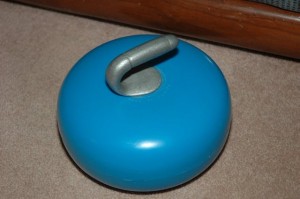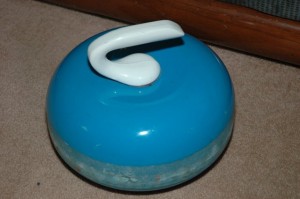Pebbles to Boulders: From Jam Cans to Little Rocks – Part 1
There is a generation that might think Little Rock curling stones have been around forever. It might seem that way, where in fact there has been a transformation over the decades. Let us take a look at where Little Rock curling stones have come from.
Many books on curling history will tell you that the sport of curling had a boom with participation during the years after World War II. When you look at a lot of curling club-building corner stones, they will read a date from the 1950’s or 1960’s. Adults flocked to the clubs to be part of this rock-throwing craze. Advances in youth programs also took place, with the junior aged youth, those 13 years of age and older. In the majority of cases, youth younger than 13 years were not physically strong enough to propel the 44 lb. granite stone down the ice. You also have to remember that advances in ice technology were not as refined as they are today, therefore more effort to throw the rock was needed than on the keen ice surfaces of today.
In 1945, the Principal of Lakeview School in Saskatchewan, Harold Covell came up with the idea to have a fun outdoor game by throwing jam cans down a snow cleared ice surface. In those days, jam was bought at the store in cans, about the size of a 2 litre can of paint (okay, I know paint does not come in 2 litre sizes, but for a moment, just imagine). The bottoms of the cans were pounded outward rounding the bottom so the can would slide on the ice. These cans were then filled with concrete to add weight; metal handles were fashioned and stuck in the concrete. When the concrete dried, you now had small rocks that kids of all ages could throw. This was called Jam Can Curling. While it is unknown who can be credited with the idea of jam can stones, these are the grand parents of the rocks we use today.
Not until the early 1980’s did the first versions of Little Rock curling stones appear. Not sure which came first, but there was a rock from Morden, Manitoba and a rock called Kids Can Curl from Ontario. The Manitoba rock was made of plastic filled with 15 lbs. of silica sand and a cast aluminum handle was placed on top. This rock was very small, well suited for the curlers aged 6 and up, but did not slide or curl very well.
The Kids Can Curl half sized rock was the creation of Dave Padgett from the Bayview Country Club in Toronto. Bayview had an active jam can league for the kids, held on Sunday afternoons. Dave, looking at this type of curling, gave plenty of thought as to how to improve curling for the kids. He came up with an injection, molded epoxy, 20 lb. rock of two colours, red and blue. The rocks have a running surface similar to regular rocks, so under the right conditions could actually curl, but had to be pushed by the cast aluminum handles to get the weight to travel the length of the ice. These rocks, while shaped and looking like curling rocks, but not really, can be credited with the explosion of elementary school aged curling. Curling administrators of the day were puzzled with what to call this group of curlers. So simply, because they play with little rocks, the age group was hence called Little Rockers. Curling clubs in Europe purchased many of these rocks and called them Cherry Rocks, for the red rocks looked like big cherries sliding down the ice.
More Little Rock stone history to follow next week.







